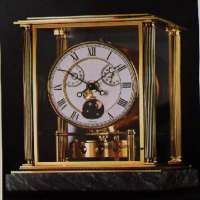Some mechanisms come very close to the idea of perpetual motion machines
or they seem to contradict the principle of energy conservation. But there
is no black magic used, as everything has an often simple natural explanation.
Drinking Bird

By courtesy of
Ostrach-Glas |
|
Many readers will know the toy which mimicks the behaviour of a drinking
bird. Body, neck and head of the bird are made of a sealed glass tube, partly
containing a liquid. The bird itself has two feet and can swing between these.
If a glass full of water is placed in front of the toy and the head dipped
into the water once, the bird continues and swings forth and back.
How does it work? The secret of the principle is the vaporisation energy
. The liqiud inside the bird vaporizes easily. The head of the bird is covered
with cloth or felt, which can hold some water. If the bird dips in, the liquid
inside the bird runs down to the body and the bird moves up. The water at
the head vaporises and by this cools the content of the tube. The liqid inside
the toy condenses and the head of the bird gets heavier, so that the bird
dips in again. The whole cyclic process runs as long as water is in the glass. |
Perpetual Clock
In 1658, Otto von Guericke named the water or mercury barometer semper
vivum, which is literally the same as Perpetuum Mobile. It is
a close idea to utlize these movements of a liquid column to operate a little
machine. The seventeenth century already saw the invention of some clockworks
being wound up by barometric devices. Some of these machines were ridiculously
large and had a weight of some hundred pounds! All this effort to keep a
clockwork running. We have to keep in mind, that the aneoride barometer was
invented much later.
Other clockworks were powered by concealed springs. All these clocks were
designed for long running time. It is no surprise that some of them were
thought to be real perpetual machines.

By courtesy of
Mike
Murray |
|
The Swiss company Jaeger-Culture manufactures a modern variant of a perpetual
clock under the trademark "Atmos". This clock is wound up by changes of
temperature and air pressure, which are even in well-climatized rooms rooms
sufficient to keep it running. |
Heat Pump
The efficiency of a modern heat pump often is given by figures of 250% or
even 300%. Is this a Maxwellian demon in technical disguise? Not at all.
In order to win energy, you have to get it from somewhere. In this case,
the heat pump tranfers energy from one reservoir (e.g. ground water) to another
reservoir (e.g. a warmwater tank in your cellar). The energy bilance is positve
in commercial terms. But if we look at the whole system, a heat pump increases
the entropy by using power to pump energy. The "loss" is the energy used
to drive the pump and some thermal losses of the pumped thermal energy between
the reservoirs.
Belusov-Zhabotinsky-Reactions
It is a well-known fact that chemical reactions do not only work in the desired
direction, but can be reversed in many cases. Until the mid-1950ies, the
chemical world was dominated by knowledge about reactions which need particular
conditions (e.g. temperature, pressure) for a maximum of resulting product.
This always was found to be some sort of equilibrum between the desired direction
and its reversed reaction. For commercial applications, chemists try very
hard to find the conditions for their processes which guarantee an optimum
of the desired product at manageable cost and technical effort.
In 1955 the chemists had understood how the citrate acid cycle in organisms
worked. In the USSR, a certain Mr. Belousov wanted to reproduce a simplified
variant of this cycle at small scale in his lab. Belousov had success and
found an oscillating chemical reaction. That was in sharp contradiction to
the well-established theory, and apparently violated the second law of
thermodynamics. It's no surprise that Belousov had enomous problems to publish
his discovery of oscillating chemical reactions. He was treated as a crackpot
and fraud. His second attempt at the beginning of the 1960ies led to a tiny
footnote in a scientific conference's papers collection. Belousov gave up.
The establishment had won - and was wrong in his case.
In 1968, Mr. Zhabotinsky learned of Belousov's results and experimetally
checked them, which is neither difficult nor expensive. And he could reproduce
the experiment. Now the time had come for the acceptance of the results.
Today we know more about these reactions and how entropy sinks can spring
up in complex chaotic systems. The second law still is unviolate.
And what about Belousov? He received the Lenin medal for his sensational
discovery. Posthumously.

